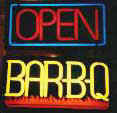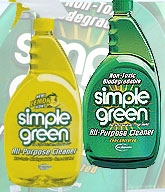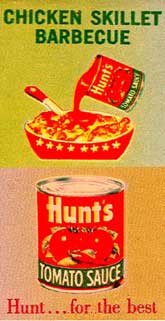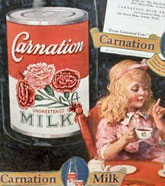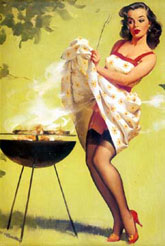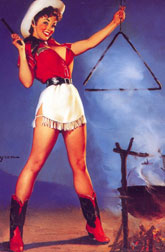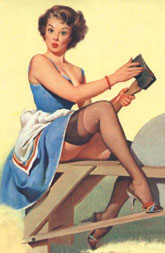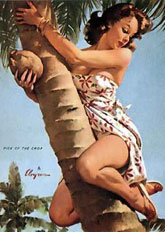Contact BBQbyDan
www.BBQDan.com
Search
KCBS BBQ Cook-Off Info
Recipes,
Smoking Meats
Recipes, Grilling
|
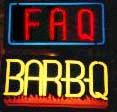 |
FAQ OF THE INTERNET BBQ LIST Version 2.0 Section 12 Science and Barbecue |
12. Science and barbecue
--------------------
[Is it dangerous to your health to eat barbecue due to the presence of carcinogens in the meat caused by the wood fire?]
Smoky Hale--
Found this on the Kansas City BBQ Forum and it seems to answer your question.
Nitrosomines, which may be produced in charred fat of certain animals, has tentatively and tenuously been linked to cancer in humans. In order for nitrosamines to be created, there must be very high temperatures (500F+) and charring. Minute quantities may, therefore, be created by careless trimming of the fat on steaks to be broiled (500-700F) and overcooked or flamed. The risk of getting cancer from this is less than drowning in the shower, IMHO.
Barbecuing is, by definition, cooked at temperatures around the boiling point of water and no competent barbecuer is likely to willingly let his meat reach the point of charring. The 'burnt ends' served by some commercial establishments are not barbecued and are more of an affront to good taste than a threat to health. If cooking meat over hot coals were a hazard to human health, the species would have starved or died out a couple million years ago. I think this is a rumor started by a vegetarian who used to be a Women's Magazine Food Editor and therefore knew nothing about barbecue. Cook slow, relax, have fun, and don't worry.
-------------------
[There was a long discussion on the List about "Fluid's Affects On Heat Transfer" in a barbecue smoker. It was way over my head. Can somebody summarize this for me?]
Jim Prather--
I wrote that post. Let's review heat transfer.
When you hold your hand close to a light bulb, you can feel heat being transferred to your hand. This is RADIATION.
Guys, when your sweet thing blows her hot breath into your ear, you feel heat being transferred to your ear. This is
CONVECTION.When you put your cold feet against that sweet thing's warm body, you feel heat being transferred to your feet. This is
CONDUCTION.Here is a simplified version of the Fluid's Affects On Heat Transfer dissertation. In it was compared a cooker to a glass of Scotch with an ice cube in it. What happens is that the surrounding Scotch transfers heat to the ice cube. This can be compared to the air in a cooker transferring heat to the enclosed meat.
The ice cube's outside surface undergoes a change of state. It is from a Solid to a Liquid. In a comparable way, in our cooker, meat loses moisture by evaporation. Also a change of state. It is from a Liquid to a Gas.
This takes place slowly in a cooker. Heat transfer to meat is by CONVECTION in a cooker. The air is cooled by the meat as the air passes by and exits the cooker. The meat receives BTUs from the passing air and its temperature rises.
The outer surface of the meat is hotter than the inside of the meat. The heat transfer inside the meat is by CONDUCTION. To reduce somewhat the higher temperature of the outside of the meat, moisture can be added to the outside by the chef person. This cools the outside by evaporation, which is still hotter than the inside of the meat. The inside of the meat continues to cook.
This adding moisture to the outside of the meat by the chef person does not add moisture to the inside of the meat, it slows the loss of moisture from the meat by temporarily cooling somewhat the outside of the meat. The outside of the meat is always hotter than the inside of the meat while the meat is in the cooker.
Occasionally, the chef person might choose to lower somewhat the temperature of the outside of the meat. Conduction will continue from the outside of the meat to the inside of the meat even as the mop is used and evaporation cools the outside of the meat. The outside of the meat will still be hotter than the inside of the meat. The inside of the meat will still continue to cook.
-------------------[I read a series of posts by an engineer on the thermodynamics of barbecuing. Is knowing any of this stuff useful in turning out a better product?]
Danny Gaulden--
I have been reading all the posts on "fluid effects on heat transfer", and enjoyed it immensely. Also learned a thing or two on the "science" of heat transfer--whether it be dry or wet heat--that's all nice, but will most likely not help you much on making good barbecue. The design and function of your smoker, and how the heat travels will have the greatest effect on how your product turns out, if you are cooking at the correct temperatures, keeping the fire right, and know when to take the meat off.
I have been lucky enough in my life to have owned a great many different smokers. Redi Smoke and Cook Shack electric, Weber, Sunbeam, Holland, and Char-Broil gas grills, Char-Broil and Weber charcoal smokers, Brinkmann, Coleman, and Mr. Meat Smoker bullet water smokers, Klose and Kingfisher big time home smokers, a couple of home made 55 gallon oil drums, and my J& R Mfg. professional rig.
I have found this to be true--after you are the best you can be in knowing how to barbecue, and really know the smoker you are cooking on, the smoker you are cooking on WILL make a difference. Some pits do a better job than others, and this is simply a fact of life. The least of your worries is about how much humidity is in the air, water pans in the smoker, and if a water smoker will cook faster than a dry smoker. If you are cooking on a first-class smoker, and have your act together, all this is irrelevant to the finished product. I do think a little moisture induced into the smoker is good, but not critical.
-------------------[Does somebody have a scientific theory for why brining poultry makes the meat more tender and moist? It can't be osmotic forces because the meat is dead.]
Bill Wight--
First of all, the membranes in dead meat cells can and do continue to conduct osmosis. In fact, several entire industries are based on the osmotic properties of semipermeable plastic membranes.
On the theory of brining, I wrote to an expert in the field, Professor Alan Sams, at Texas A & M University and asked him what the mechanism was. He sent me two reprints of scientific papers, one of his and one from Professor Jansky at the University of Florida. The papers mainly dealt with various methods of chill-brining commercial poultry but summarized the mechanism of how it works as follows: Brining makes the poultry more tender and moist because the muscle tissues take up more water. The mechanism for this was not stated in the articles. I would surmise it is a combination of simple diffusion and osmotic pressures that ends up getting more water into the muscle cells and intracellular fluids. The article stated that in the late 70's, several researchers, (Professors Hamm, Arafa, and Jansky) determined that it was this added water within the muscle tissue that made the meat more tender. And it's obvious that the added water makes the meat more moist also.
On the added saltiness of the poultry after brining, Professor Jansky states, "The average person might not increase his sodium intake substantially by consuming chicken meat from brine chilled broilers; however, this product might not be suitable for persons on sodium restricted diets." So if you are on a low sodium diet, don't brine your birds with sodium chloride.
--------------------[Can you tell me about what happens to meat while you slow cook it?]
Kit Anderson--
Meats are made of muscle, connective tissue, fat and bone. Muscle contains proteins and glycogen. As the temperature of the meat increases, glycogen, a long chain sugar, is reduced to simple sugars. This caramelizes and is responsible for one of the flavor components.
Proteins (flavorless) are denatured to amino acids, which not only have flavors themselves, but also undergo Maillard browning reactions, which adds another flavor component.
While bone adds no flavor itself, the marrow is rich in methyglobulin and other proteins. This reacts with smoke nitrites to give us the smoke ring. You may have heard that "the sweetest meat is next to the bone". The proteins are reduced to amino acids. Nutrasweet is an amino acid.
Fat is a very simple molecule that fills the fat cells in muscle tissue. Fat breaks down to sugars, fatty acids, and triglycerides at low temperatures.
Collagen is proteins that have lots of side chain bonds. This makes them elastic. It takes more energy to denature them than the simpler proteins of muscle tissue. Energy in the form of heat will denature these proteins into the flavorful amino acids.
If the temperature is too high, the water in the muscle cells and the fat is rendered out before the collagen melts. This results in dry, tough meat. Too low a temperature and you risk bacterial activity.
Tough cuts of meat like brisket and pork butts benefit from low temperature cooking as the collagen adds flavor to the meat. Less tough, more expensive cuts do not need this phase and can be cooked at high temperatures for shorter periods. That is why ribs take only a few hours and briskets take up to 20 hours.
-------------------[I thought that the reason to raise the meat to room temperature for a wood burner was to avoid condensation of undesirables in the smoke on the meat. For this reason, I bring the meat to room temperature, put it into my electric bullet smoker, then wait a little while before I add the wood chunks. Lately I've read that experienced List members put cold meat into their smokers to get a better smoke ring and more smoke flavor. What's going on?]
Danny Gaulden--
For 22 years I have taken the day's cooking straight from the walk in refrigerator in my restaurant and into the cool smoker. The temperature in the pit will usually be around 125 to 140F. I have always felt if one wanted more smoke flavor and a deeper smoke ring, this was the way to do it. My reasoning behind this is that I feel the meat is more relaxed, and the pores are more open when the meat is cold. The smoke draws to it like a magnet. Just like creosote does to a cold chimney until it gets heated up.
Now, here is where some of our novice smokers can get into trouble. If your fire isn't established, and is in a high burn when you put on the meat, and you close the fire damper down too much to try to keep the temperature down in your smoker for awhile, you will get even more creosote on the cold meat than if you had let the meat reach room temperature first. Not only will the 'good smoke' draw to the meat, the 'bad smoke' will also. That's why I have stated in some of my earlier post to let the meat rest out of the refrigerator for a bit before placing it in the heated smoker. It was less of a risk for a lot of you and simply safer. However, it seems that some of the ones who have been smoking meat for a few months are becoming good pitmasters, and we can discuss things at a more advanced level. My problem with some of the things I do is that I don't know how to explain them, I just know that they work. I guess that's why we have Kit around to help explain the science behind what we're doing. From him, I have learned a lot about why what I do works and can talk to people on a more intellectual level about it. It's always better to understand why something works, not just that it works.
If you are using a water smoker, be it an electric, gas, or charcoal burner, this cold meat technique shouldn't be much of a problem. Nor should it be with the Cookshack, etc. However, doing this with a straight wood burners can be more challenging. You must know how to start out with a low-heat fire, fairly smoky, and slowly bring the heat up without causing a great commotion. It may be easier for you to go ahead and make a larger fire, let it burn down to mostly coals, then throw in one piece of greener wood for smoke in the early stages. That way, you can go ahead and close down your firebox damper a bit without the problem of creosote, and maintain a lower heat in the cooking chamber for awhile. Notice I said just for awhile. It's much easier to have a good bed of coals in the firebox, and just add a log here and there to maintain and increase the heat, than to have too few coals and have to chuck in a bunch of wood to bring the temperature up. I do not maintain this low temperature cooking for a long time. I am continually slowly bringing up the temperature until I reach about 240F in the cooking chamber. With the cold meat placed in the cool smoker, and starting out with a cool, but clean-burning fire that I slowly bring up, the meat turns out nice and smoky and with a great smoke ring every time.
==============Kit Anderson--
I just got a copy of 'Professional Charcuterie' on Bill Ackerman's recommendation. It is a great book on sausage making. One particular point of interest is the smoking technique. Most of the recipes involving smoking call for putting the meat in at 135F for a hour, going up to 155F, then higher until the internal temp reaches 160F.
This is not cold smoking, which is done at 80F. The purpose is to get the smoke ring and its associated flavor to form at a maximum depth. The reaction stops when the meat gets over 120F, or so. This makes a lot of sense when looking for 'bacon-on-a-stick' ribs. I have advocated putting the cold ribs in a cold smoker and then starting the fire to achieve this. It gives a smoke ring all the way through on baby backs but not all the way through on spareribs.
This past weekend, I was visiting a friend that has a SnP Pro. He was cooking spares and had lowered the grill in the cooking chamber to fit 6 full racks. He said he liked to smoke at 200F but was having trouble with the ribs being tough. I saw that he was monitoring temperatures on the lid which meant the temperature at grill level was probably no higher than 135-150F. He is Polder challenged. The ribs had been on for 3 hours when I got there.
So, I boosted the temperature up to 300F for two hours until dry bone started to show on the ends. I could easily pull the ribs apart and found that the smoke ring went all the way through. Bacon-on-a-stick spares, tender and moist. Try the initial low temperature for a few hours next time you do ribs.
I did some research and found these Web sites on the smoking reactions in meat.
![]() Click here to visit the first Web site.
Click here to visit the first Web site.
![]() Click here to visit the second Web
site.
Click here to visit the second Web
site.
65C (149F) but most proteins start to denature at 120F. I think this is the temperature when the enzymes are denatured and there is only heat affecting the myoglobin. Note lines 4,5,6 in the table. They are the curing or smoke ring reactions. Reactions 7 and above are the heat reactions because the myoglobin begins to denature.
What I learned and didn't know before was that bacteria are involved in changing sodium nitrate to nitric oxide which bonds to the myoglobin at the site where oxygen would normally occupy. Since these bacteria die at 140 and are very active at 120, that accounts for smoke ring depth. Also, that there are three different smoke ring reactions giving different colors based on the amount of oxidation the meat had before it started cooking. There are three types of those reactions. That's why there are pink, red and purple smoke rings.
-------------------[Does the smoke ring have a taste?]
Kit Anderson--
Yes. The reaction of nitrates and nitrites in smoke, or chemical cures, with methyglobin in meat results in the typical color we see in ham and other processed meats. This also has a distinctive flavor. For instance, if you brine a brisket, it will taste more like ham than beef. This is how turkey ham is made.
While the smoke ring does not show the total penetration of the smoke, its color and size are an indication of the activity of the smoke when cooking.
So, you can produce thinner cuts of meat with a smoke ring all the way through and things like baby back ribs will taste like 'bacon on a stick'. This reaction takes place below 120F. So, in order to do this, you must put the ribs on when they are cold rather than letting them come to room temperature. The smoker should not be too hot, 225F is good. You should not use a ton of smoke. It will condense out causing the meat to be bitter.
This is not the only way to barbecue ribs. It is only one way to get a very unique flavor.
Editor--
I think in light of the many question asked (and some answered by Kit and Danny) about the subject of barbecue smoke, smoke rings, smoke flavor and creosote, it might be helpful if we take a look at this from a physical chemical point of view.
-------------------[What is barbecue smoke?]
Bill Wight--
Barbecue smoke is a complex combination of particulates and gases that results from the burning of wood. When wood burns, many different kinds of combustion by-products are produced--this is a very complicated process and is affected by many variables, such as temperature of the fire, the amount of oxygen available, the humidity, the type of wood, the age of wood, etc.
Particulates--
What you see in smoke are actually the particulates, tiny bits of matter, from white ash, to black carbon and many other materials. The sizes of these particles range from about 10 microns down to less than 1 micron. A micron is one millionth of a meter--bacteria are in this size range. In addition to the carbon and ash, there are also some inorganic chemicals that are carried on the smoke particles, such as nitrates and nitrites, usually as salts of sodium and calcium. The type of particulates that a wood-burning fire produces is dependent on how clean, or complete, the combustion process is, what kind of wood was burned, the age of the wood, etc. A clean-burning fire, one that has all the oxygen it needs, will produce few particulates and a dirty fire, or one that is starved for oxygen, will produce heavy particulates--including ash and soot. John Willingham calls these smoke particulates 'dirt' and says that they are undesirable in the smoking process. The particulate solids in the smoke cannot diffuse into the meat--they are much too big to do that. The particulates stay on the surface of the meat. When we get a dirty fire that generates lots of particulates, these materials do collect onto the surface of the meat. This is why the meat turns black, from the soot that is generated by a poorly-managed fire. The meat will also get black from the burning of sugars in the rubs or sauces that are put on the meat, but that is another process.
An experienced wood-burning barbecuer will manage his fire in a way that very few particulates are ever produced. His end product will come out of the cooking chamber a beautiful deep, reddish-brown color. It will be free of any black sooty look. He has managed during the entire course of the smoking process to keep his fire at the correct level of fuel, air and heat, so that at no point during the smoking process did he let the fire produce any soot or ash. The wood-burning beginner, however, will have periods during the smoking process when the fire is well-managed and periods when the fire is poorly-managed. During these poorly-managed periods, the fire will produce soot, ash and creosote, all of which are detrimental to the finished barbecue product. At the end of the smoking process, the meat may look black and sooty, and will probably have a bitter, or 'over-smoked' taste. As the beginner gains experience with fire management, the periods when the fire is 'out of control' will occur less and less. After a year or so of smoking, the beginner now finds that his meat is coming out of the smoker looking and tasting like something that could win grand prize at the state barbecue championship.
Gases--
The gases in wood smoke are invisible, like air, and cannot be seen. These gases contain carbon dioxide, carbon monoxide, water vapor, and many other chemicals. Wood is a complex material, containing solids, liquids and gases. As the wood seasons, the gases leave quickly and the liquids leave over a period of months and years. The complex organic chemicals within wood are termed 'secondary metabolites'. These chemicals are produced by the living cells of the tree and are important for the tree's growth, maintenance and protection. These chemicals are classified by wood chemists into the following categories: volatile oils, resins, fats and waxes, lignans, and simple and complex carbohydrates. A typical tree may produce and store about a hundred of these organic chemicals within its cells and bark. When these chemicals burn, by-product gases are given off in the smoke. There is a big difference in the composition of the gases that come off a clean-burning wood fire and those that come off a smoldering wood fire. One class of chemicals that comes off a smoldering fire are called polycyclic aromatic hydrocarbons and contain some really nasty stuff, some of them known to be carcinogenic.
It is beyond our interests to go any deeper into the chemistry of burning wood, but we can simplify all this by saying that when barbecuers talk about 'good smoke' they are really talking about not the particulates we can see, or the carbon dioxide or water vapor gases, but a class of chemicals we will call 'smoke flavoring gases'. From my reading, I do not believe that this class of chemicals is at all well understood.
Only the gases that result from the burning of the wood can get past the surface and into the depths of the meat.
Creosote--
The term 'creosote' refers to a group of oily, bitter-tasting organic chemicals that are produced during the fractional distillation of wood and coal. When creosote is produced commercially, freshly cut wood is put into a distillation tower and heated with very little oxygen present. The gases produced by this distillation process are condensed on cooling coils in the top of the tower. In a smoker, we can get similar conditions--an oxygen-starved fire, with the meat and the walls of the smoker becoming the condensation surfaces. If your fire is well managed and you are using seasoned wood, you will not have a problem with creosote forming and condensing on the meat. If your fire is starved for oxygen and maybe some of your wood is a bit green, then it is very likely that creosote will be produced and will find its way into your meat. Creosote in the smoke is a gas and not a particulate. It condenses out of the gas as a sticky liquid. This creosote liquid can get into the cells of the meat, so it is not just on the outside of the meat.
-------------------[How does the smoke get into the meat?]
Bill Wight--
So now that we have a little more information on what smoke is, we can understand that smoke absorption and adsorption by the meat is a complicated and highly variable process. There are several physical processes that are taking place within your smoker.
Adsorption--
A process where the smoke particulates and gases are deposited onto the outside surface of the meat.
Absorption--
A process where the smoke gases are transported into the cellular fluids within the meat.
Diffusion--
The term diffusion in non-technical language refers to the process whereby liquids and gases go from an area of higher concentration to an area of lower concentration. In barbecue, the gases produced by the wood-burning fire are more concentrated in the smoke surrounding the meat and less concentrated in the liquids of the cells within the meat. So there is a 'driving force' that works to push the smoke gases into the meat.
Solution--
This is a term that refers to a liquid, a solid or a gas dissolving into another liquid. When you make a brine, you put salt into water. The salt goes into solution in the water. Gases also go into solution in liquids, as in carbonated sodas. Here, the gas carbon dioxide goes into solution in the sugar-flavored water. Liquids can go into liquids as when you add molasses to water.
Solution-Diffusion--
This is the process that describes how a liquid, a solid or gas goes into another liquid and moves into and mixes throughout the liquid. In the example of carbonated soda, the carbon dioxide gas is applied to the surface of the sugar water and the carbon dioxide gas goes into all the liquid by the process of solution diffusion. It first goes into solution at the surface and then diffuses throughout the liquid. If you place a spoonful of salt in a glass of water and leave it undisturbed, in a few hours or days, the salt will have gone into solution and the salt ions will have diffused throughout the liquid.
Saturation--
The term saturation means that a fluid cannot dissolve and hold any more solids or gases, it has become saturated. In the soda example, only so much sugar can be added to the water. When the water is saturated with sugar, no more sugar crystals will dissolve into the liquid. When carbon dioxide gas is added to the soda, only so much will go into solution. When the soda is saturated with carbon dioxide, then no more of that gas can be dissolved in the sugar water. Temperature affects the saturation point. With warmer liquids usually being able to hold more solids than cooler liquids (we warm a brine to help the salt dissolve) and cooler liquids being able to hold more gases than warmer liquids (when we warm a soda, the carbon dioxide gas comes off as bubbles). In barbecue, there will come a point where the fluids within the muscle tissue will become saturated in the smoke flavoring gases and liquids and no more gases and liquids can be added to the cellular fluid. This may be one reason why putting cold meat into the smoker may increase the smoky flavor, as the cold fluids in the muscle cells will take-up the smoke flavoring gases and liquids faster than hot fluids.
-------------------[What does this solution-diffusion process have to do with making good barbecue?]
Bill Wight--
Meat is really muscle tissue that basically consists of cell membranes, a combination of many types of proteins and cellular fluids, containing water and dissolved solids (for example salts and sugars) and gases and liquids (oxygen and carbon dioxide). When we smoke a piece of meat, what is happening is that the smoke flavoring gases and liquids are coming from the wood burning process into the cooking chamber and into contact with the cell membranes of the outer muscle tissue. The smoke gases and liquids diffuse across the muscle cell membranes and go into solution in the cellular fluids. The driving force here is that the gases and liquids are soluble in the cellular fluids and are in a higher concentration in the atmosphere of the cooking chamber than they are in the cellular fluids. So the process of diffusion drives these gases and liquids into the cellular fluids. Once across the cell membrane, the gases and liquids go into solution in the cellular fluids and then diffuse throughout the cell. The gases and liquids then diffuse out of the first cell and into the next cell in contact with the first and the process starts again in that cell. This is how the smoke flavoring gases and liquids get deep inside the meat, as much as a an inch in longer smoking sessions. Some of the smoke flavoring gases condense out as liquids on the surface of the meat. These liquids then begin to diffuse across the cell membrane into the cells and cellular liquids of the muscle tissue. So we have some of the flavoring agents from the smoke diffusing into the meat as gases and some diffusing into the meat as liquids.
-------------------[Is this solution-diffusion a steady process?]
Bill Wight--
The cells within the meat accept these smoke flavoring gases and liquids more readily when it is raw and cool and first put into the smoker and gradually accept less and less of these smoke flavoring gases and liquids as the cooking process continues. There is probably no absolute cutoff point, like after 2 hours, where the meat stops accepting these smoke flavoring gases and liquids. As the smoking process continues several conditions are changing. The meat is shrinking and it's surface and texture are becoming less permeable as it cooks and browns (the bark is forming) and this makes it more difficult for the smoke flavoring gases and liquids to diffuse into the meat.
Now we need to also know a little more about diffusion, the process that gets the smoke flavoring gases and liquids into the meat. When we speak of diffusion, we are talking about a process that wants to equalize itself, to attain a state of equilibrium. For example, when someone is in a room and smoking a cigarette, the smoke and gases of the combustion of the tobacco begin immediately to diffuse out into the air of the room. If the person has only one cigarette and then stops smoking, the diffusion process continues until every part of the room air has the same concentration of smoke, until the smoke in the room has attained a 'state of equilibrium'. Now, if we were to start with a clean room and erect a barrier across the middle of it that is made of paper, and this paper barrier is taped to the walls and floor and ceiling so that the only way for the smoke to get into the part of the room on the other side of the barrier is to go through the pores of the paper. Now when the person smokes one cigarette the smoke will diffuse throughout their side of the room but the smoke but will have trouble, or be impeded from diffusing, into the other side of the room because of the paper barrier. Eventually, the smoke will diffuse through the paper barrier until the smoke concentration is the same on both sides of the paper barrier. The process of diffusion is driven by an unequal amount of smoke on each side of the paper barrier. When we start out, the smoke is more concentrated on one side of the paper barrier and less concentrated on the other side of the barrier. As time goes on, the smoke gradually becomes equal on both sides. The smoke will never be in a higher concentration on the other side of the barrier, as there is no force that will make smoke concentrate on the far side of the paper barrier. The smoke must eventually come to a state of equilibrium in both parts of the room.
Now let's imagine that the paper barrier across the room represents the surface of the meat and the cell membranes of the muscle tissues within the meat. Let's make this example more like smoking meat and say that when the smoking process first starts, the pores in the paper barrier are large, and smoke will diffuse through the paper at a fast rate and as the smoking process continues the pores in the paper 'clog up' and get smaller and the smoke diffuses through the pores at a slower rate. As we smoke a piece of meat, several things are happening. First the 'pores' of the meat are more open and the smoke flavoring gases and liquids can go through these bigger holes at a faster rate. Also, when we start the smoking process, the meat has no smoke flavoring gases and liquids dissolved in the fluids of the muscle cells of the meat and therefore there is a higher driving force available to drive the flavoring gases and liquids into the fluids within the cells. As the smoking process continues, the pores of the meat get smaller and the 'skin' on outside of the meat gets thicker. So the overall effect is that the smoke flavoring gases and liquids cannot go into the meat as fast as they did at the start. As the smoking process goes on, less and less of these gases and liquids can get into the meat. Also, as the smoking process continues, the fluids with the cells get closer to the point of saturation of the smoke flavoring gases and liquids. At some point in the smoking process, no additional smoke flavoring gases and liquids can be absorbed or taken into the fluids of the cells.
-------------------[OK, I understand that it is getting harder for the gases and liquids to get inside the meat as the smoking process continues, but is there a point where no more smoke flavor is imparted to the meat?]
Danny Gaulden--
Even though the smoke flavoring gases and liquids may not penetrate the meat nearly as deep after a few hours of smoking, I feel they still continue to be adsorbed on the outer surface of the meat. The smoke flavor can become quite strong and bitter if the fire is not managed correctly, or it can be a positive addition to the flavor if the fire is well-managed. Smoking beyond the 2-6 hour period definitely adds more 'smoke flavor' to the meat, and there is a great distinction in flavor between 'smoked until done' meats, and meats that were smoked for a few hours, then finished off with just heat, by being wrapped in foil and left in the smoker or put into an oven.
When one takes a bite and starts to chew, the eater doesn't know if the smoke flavor is coming from the center of the meat, the outer third, or the outside surface. He just knows it tastes smoky. So, I feel that the 'continue smoking until done' process does add flavor all the way through the cooking process. To what degree this is attained depends on how smoky one wants their meat to be, and how well they manage their fire.
-------------------[Why can't we wash off the creosote taste once it gets on the meat?]
Bill Wight--
The creosotes that form from a poorly-managed fire are gases and these gases condense on the surface of the meat. Once on the surface, they diffuse into the interior of the meat. So a piece of meat that has been subjected to creosote conditions for a long period of time cannot be rescued by washing it off, as the bitter-tasting chemicals have penetrated into the meat. If the creosote condition lasts only a few minutes, then it may be possible to wash off the meat, or cut off the bark, and remove the bitter tasting layer and save the meat. But if the creosote conditions remain in the smoker for a longer time, then you have almost surly ruined the meat as the bitter taste will have gone too deeply into the meat to be removed. Danny Gaulden has testified to this in his early days of smoking. He's had a few pieces of meat that were totally ruined because his fire got out of control and produced some nasty creosote that went so deeply into the meat that the bitter parts could not be trimmed off.
-------------------[Does the smoke ring continue to grow as long as the meat is in the smoker and there is smoke?]
Kit Anderson--
The smoke ring reaction stops when the meat gets to about 120F. The smoke ring is only one of the reactions taking place in the meat and has its own associated flavor but smoke penetration is temperature dependent.
-------------------[How do you suppose that the nitrate and nitrite salts get onto the meat from the fire? Are they carried aloft as salts attached to the particulates in the smoke?]
Kit--
The ash is loaded with potassium and sodium nitrates. That's why you need wood smoke to get a smoke ring.
-------------------[So you need some particulates in your smoke too, not just the gases?]
Kit--
Right. With charcoal, you get no smoke. With lump, you get a little. With lump and wood you get more, with just wood you get the most. With each, an increase in smoke ring depth. Nitrates are organic salts and cannot by themselves be gases.
Go to the next section
Return to the Table of Contents
Return to the BBQ FAQ Home Page
Comments or Suggestions
BBQ FAQ Ver 1.0, 2.0 ©1997, 1998 William W. Wight. All rights reserved.

